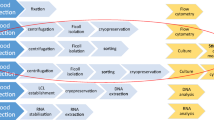Abstract
The discovery that the fertilized mouse ovum triggers an increased demand for platelets and results in thrombocytopenia during the preimplantation phase of pregnancy provides a monitor for embryo survival and viability. This paper reports a study in which the platelet count was significantly reduced throughout the human preimplantation phase of pregnancy and returned to normal following embryo implantation. The human embryo was shown to produce a platelet activating factor in vitro which caused the reduction in platelet count after embryo transfer. This factor in the embryo culture medium could be measured using a bioassay which provided a means of assessing embryo viability prior to transfer. Some women showed no reduction in platelets after transfer. These embryos failed to produce a platelet activating factor in vitro and pregnancy was not established. Other women displayed a reduction in platelets following transfer but failed to become pregnant. All of these women had elevated luteal-phase plasma E2 levels compared to pregnant patients, which may have interfered with the implantation process. Our observations provide a possible rapid and simple means for monitoring the viability of human embryos cultured in vitro and the survival of embryos in utero.
Similar content being viewed by others
References
Roberts CJ, Lowe CR: Where have all the conceptions gone? Lancet 1975;1:498
Smart YC, Fraser IS, Roberts TK, Clancy RL, Cripps AW: Fertilization and early pregnancy loss in healthy women attempting conception. Clin Reprod Fertil 1982;1:177–184
Lopata A: Concepts in humanin vitro fertilization and embryo transfer. Fertil Steril 1983;40:289–301
Jones HW, Acosta AA, Andrews MC, et al.: What is a pregnancy? A question for programs ofin vitro fertilization. Fertil Steril 1983;40:728–733.
O'Neill C: Thrombocytopenia is an initial maternal response to fertilization in the mouse. J Reprod Fertil 1985;73:559–566.
O'Neill C: Examination of the cause of early pregnancy associated thrombocytopenia. J Reprod Fertil 1985;73:567–577.
Smith DH, Picker RH, Sinosich M, Saunders DM: Assessment of ovulation by ultrasound and oestradiol levels during spontaneous and induced cycles. Fertil Steril 1980;33:387–390
Renou P, Trounson AO, Wood E, Leeton JF: The collection of human oocytes forin vitro fertilization. I. An instrument for maximizing oocyte recovery rate. Fertil Steril 1981;35:409–412
Wood C, Leeton JF, McTalbot J, Trounson AO: Technique for collecting mature human oocytes forin vitro fertilization. Br J Obstet Gynaecol 1981;88:756–769.
Becker G, Cronkite E: Morphology and enumeration of human blood platelets. J Appl Physiol 1950;3:365–371
Guerrero R, Aso T, Brenner PF, et al.: Studies on the pattern of circulating steroids in the normal menstrual cycle. Acta Endocrinol 1976;81:133–149.
Frojmovic MM, Milton JG: Human platelet size, shape and related functions in health and disease. Physiol Rev 1982;62:185–261
Ward CV, MacArthur JL: Blood platelet studies during pregnancy and the puerperium. Am J Obstet Gynecol 1948;55:600–608
Dittmer DS: Blood and Other Body Fluids: Biological Handbook. Washington DC, Federation of American Societies for Experimental Biology, 1961
Sharper AG, Kear J, MacIntosh D: The platelet count, platelet adhesiveness and aggregation and the mechanism of fibrinolytic inhibition in pregnancy and puerperium. J Obstet Gynaecol Br Common 1968;75:433
Rebadi S: Blood platelets during pregnancy, labor, the puerperium and menstruation and the newborn. Am J Obstet 1907;2:475
Mor A, Yang W, Schwarz A, Jones WC: Platelet counts in pregnancy and labor. Obstet Gynecol 1968;16:338–342.
Talbert LM, Langdell R: Normal values of certain factors in the blood clotting mechanism in pregnancy. Am J Obstet Gynecol 1964;90:44–47
Todd ME, Thompson JH, Bowie EJW: Changes in blood coagulation during pregnancy. Mayo Clin Proc 1965:370–377
Pitkin RM, Witte DL: Platelet and leukocyte counts in pregnancy. JAMA 1979;242:2696
Sejeny SA, Eastham RD, Baker SR: Platelet counts during normal pregnancy. J Clin Pathol 1975;28:812–813
O'Brien JR: Platelet count in normal pregnancy. J Clin Pathol 1976;29:174
McBain JC, Pepperell RJ, Robinson HP, Smith MA, Brown JB: An unexpectedly high rate of ectopic pregnancy following induction of ovulation with human pituitary and chorionic gonadotrophin. Br J Obstet Gynaecol 1980;87:5–9
Morris JM, Van Wagenan G: Interception: The use of post ovulatory oestrogens to prevent implantation. Am J Obstet Gynecol 1973;115:101–106
O'Neill C, Saunders DM: Assessment of embryo quality. Lancet 1984;2:1035
Author information
Authors and Affiliations
Rights and permissions
About this article
Cite this article
O'Neill, C., Gidley-Baird, A.A., Pike, I.L. et al. Maternal blood platelet physiology and luteal-phase endocrinology as a means of monitoring pre- and postimplantation embryo viability following in vitro fertilization. J Assist Reprod Genet 2, 87–93 (1985). https://doi.org/10.1007/BF01139339
Accepted:
Issue Date:
DOI: https://doi.org/10.1007/BF01139339




